Nearshore Dynamics of Storm Surges and Waves Induced by the 2018 Typhoons Jebi and Trami Based on the Analysis of Video Footage Recorded on the Coasts of Wakayama, Japan
Abstract
1. Introduction
2. Post-Event Surveys after the Typhoons
2.1. Damage Caused by Typhoon Jebi
2.2. Damage Caused by Typhoon Trami
2.3. Comparison of Inundation Characteristics of Jebi and Trami
3. Numerical Simulation
4. Analysis of Tide Gauge Records
5. Image Analysis of Video Footage Recorded at the Coast
5.1. Video Footage Recorded at Kushimoto Town
5.2. Video Footage Recorded at Yura Town
6. Discussion and Conclusions
Author Contributions
Funding
Acknowledgments
Conflicts of Interest
Appendix A
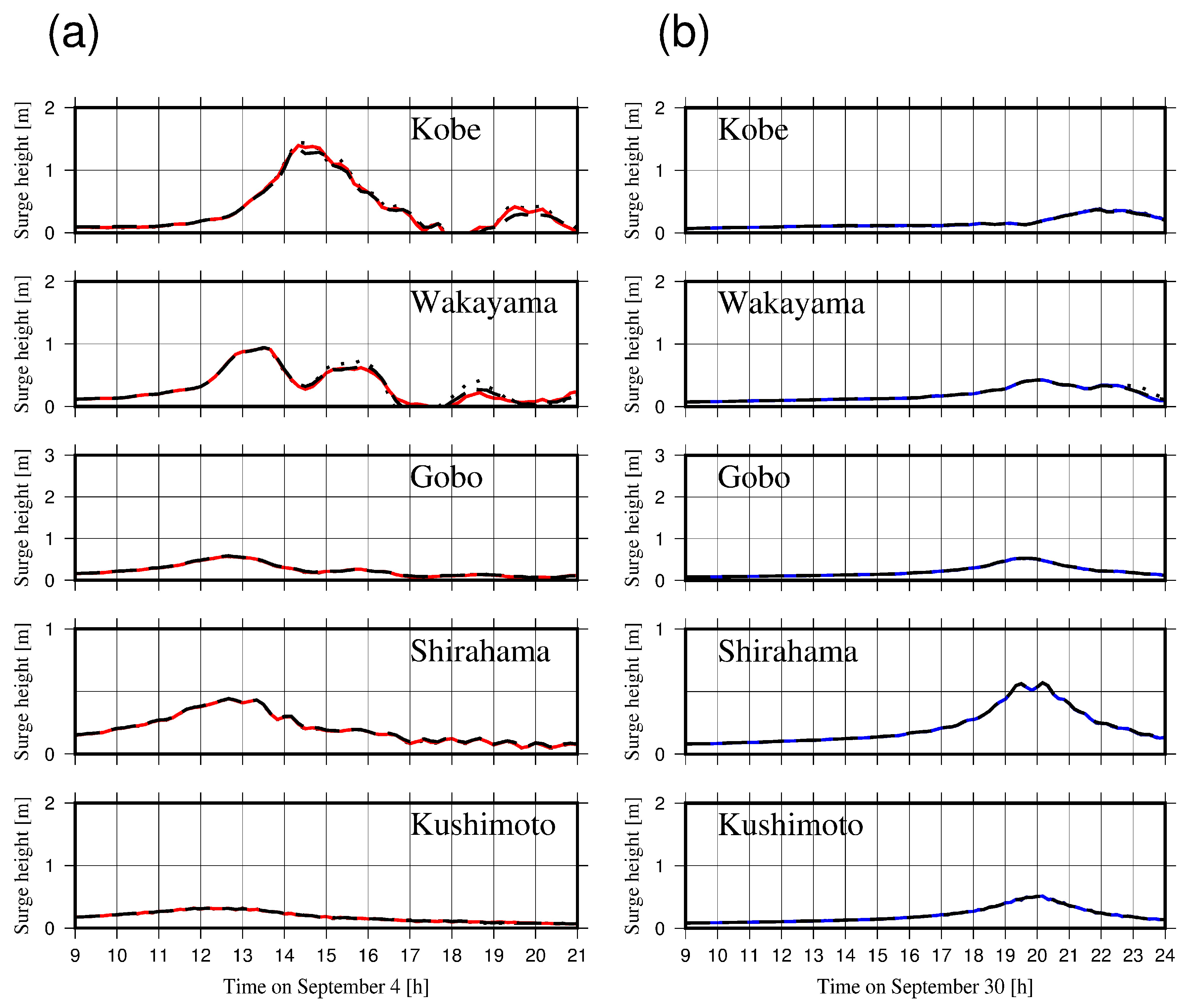
References
- Cox, D.; Arikawa, T.; Barbosa, A.; Guannel, G.; Inazu, D.; Kennedy, A.; Li, Y.; Mori, N.; Perry, K.; Prevatt, D.; et al. Hurricanes Irma and Maria post-event survey in US Virgin Islands. Coast. Eng. J. 2019, 61, 121–134. [Google Scholar] [CrossRef]
- Tajima, Y.; Yasuda, T.; Pacheco, B.M.; Cruz, E.C.; Kawasaki, K.; Nobuoka, H.; Miyamoto, M.; Asano, Y.; Arikawa, T.; Ortigas, N.M.; et al. Initial report of jsce-pice joint survey on the storm surge disaster caused by typhoon haiyan. Coast. Eng. J. 2014, 56, 1450006. [Google Scholar] [CrossRef]
- Mori, N.; Kato, M.; Kim, S.; Mase, H.; Shibutani, Y.; Takemi, T.; Tsuboki, K.; Yasuda, T. Local amplification of storm surge by Super Typhoon Haiyan in Leyte Gulf. Geophys. Res. Lett. 2014, 41, 5106–5113. [Google Scholar] [CrossRef] [PubMed]
- Sopkin, K.L.; Stockdon, H.F.; Doran, K.S.; Plant, N.G.; Morgan, K.L.M.; Guy, K.K.; Smith, K.E.L. Hurricane Sandy: Observations and Analysis of Coastal Change; US Geological Survey: Reston, VA, USA, 2014.
- Fritz, H.M.; Blount, C.; Sokoloski, R.; Singleton, J.; Fuggle, A.; McAdoo, B.G.; Moore, A.; Grass, C.; Tate, B. Hurricane Katrina storm surge distribution and field observations on the Mississippi Barrier Islands. Estuarine, Coast. Shelf Sci. 2007, 74, 12–20. [Google Scholar] [CrossRef]
- Knutson, T.R.; McBride, J.L.; Chan, J.C.L.; Emanuel, K.; Holland, G.; Landsea, C.; Held, I.; Kossin, J.P.; Srivastava, A.K.; Sugi, M. Tropical cyclones and climate change. Nat. Geosci. 2010, 3, 157–163. [Google Scholar] [CrossRef]
- Webster, P.J.; Holland, G.J.; Curry, J.A.; Chang, H.-R. Changes in Tropical Cyclone Number, Duration, and Intensity in a Warming Environment. Science 2005, 309, 1844–1846. [Google Scholar] [CrossRef]
- Bruneau, N.; Griser, J.; Loridan, T.; Bellone, E.; Khare, S. The impact of extra-tropical transitioning on storm surge and waves in catastrophe risk modeling: Application to the Japanese coastline. Nat. Hazards 2017, 85, 649–667. [Google Scholar] [CrossRef]
- Karaca, E.; Aslani, H. Review of two Japan Typhoon catastrophe models for commercial and industrial properties. Nat. Hazards 2016, 83, 19–40. [Google Scholar] [CrossRef]
- Kim, S.; Matsumi, Y.; Yasuda, T.; Mase, H. Storm surges along the Tottori coasts following a typhoon. Ocean. Eng. 2014, 91, 133–145. [Google Scholar] [CrossRef]
- Kawabata, T.; Kunii, M.; Bessho, K.; Kanazawa, T. Reanalysis and reforecast of Typhoon Vera (1959) using a mesoscale four-dimensional variational assimilation system. J. Meteorol. Soc. Jpn. 2012, 90, 467–491. [Google Scholar] [CrossRef][Green Version]
- Arakawa, H. Typhoon Vera and its Induced Storm Tide. Weatherwise 1960, 13, 150–152. [Google Scholar] [CrossRef]
- Mori, N.; Yasuda, T.; Arikawa, T.; Kataoka, T.; Nakajo, S.; Suzuki, K.; Yamanaka, Y.; Webb, A. 2018 Typhoon Jebi post-event survey of coastal damage in the Kansai region, Japan. Coast. Eng. J. 2019, 61, 278–294. [Google Scholar] [CrossRef]
- Japan Meteorological Agency. Strong Wind and Storm Surge Caused by Typhoon No. 21 in 2018, (Written in Japanese); Technical Report; Japan Meteorological Agency: Tokyo, Japan, 2018; Available online: http://www.data.jma.go.jp/obd/stats/data/bosai/report/2018/20180911/20180911.html (accessed on 18 April 2019).
- Japan Meteorological Agency. Strong Wind and Storm Surge Caused by Typhoon No. 24 in 2018 (Written in Japanese); Technical Report; Japan Meteorological Agency: Tokyo, Japan, 2018; Available online: http://www.data.jma.go.jp/obd/stats/data/bosai/report/2018/20181011/20181011.html (accessed on 18 April 2019).
- Japan Meteorological Agency. Track Data of Typhoons in 2018, (in Japanese); Technical Report; Japan Meteorological Agency: Tokyo, Japan, 2018; Available online: https://www.data.jma.go.jp/fcd/yoho/typhoon/route_map/bstv2018.html (accessed on 6 December 2018).
- Takabatake, T.; Mäll, M.; Esteban, M.; Nakamura, R.; Kyaw, T.O.; Ishii, H.; Valdez, J.J.; Nishida, Y.; Noya, F.; Shibayama, T. Field Survey of 2018 Typhoon Jebi in Japan: Lessons for Disaster Risk Management. Geosciences 2018, 8, 412. [Google Scholar] [CrossRef]
- Yamanaka, Y.; Shibata, R.; Tajima, Y.; Okami, N. Inundation characteristics in Arida City due to overtopping waves induced by 2018 Typhoon Jebi. Proceedings of International Conference on Asian and Pacific Coasts 2019, Hanoi, Vietnam, 25–28 September 2019; pp. 199–206. [Google Scholar]
- WW3DG (The WAVEWATCH Ⅲ Development Group). User Manual and System Documentation of Wavewatch III Version 5.16; Tech. Note 329; NOAA/NWS/NCEP/MMAB: College Park, MD, USA, 2016. [Google Scholar]
- Tajima, Y.; Gunasekara, K.H.; Shimozono, T.; Cruz, E.C. Study on Locally Varying Inundation Characteristics Induced by Super Typhoon Haiyan. Part 1: Dynamic Behavior of Storm Surge and Waves Around San Pedro Bay. Coast. Eng. J. 2016, 58, 1640002. [Google Scholar] [CrossRef]
- Weatherall, P.; Marks, K.M.; Jakobsson, M.; Schmitt, T.; Tani, S.; Arndt, J.E.; Rovere, M.; Chayes, D.; Ferrini, V.; Wigley, R. A new digital bathymetric model of the world’s oceans. Earth Space Sci. 2015, 2, 331–345. [Google Scholar] [CrossRef]
- Ezer, T.; Oey, L.-Y.; Wang, D.-P.; Fan, S.-J.; Yin, X.-Q.; Oey, L.; Wang, D.; Fan, S.; Yin, X. Loop Current warming by Hurricane Wilma. Geophys. Res. Lett. 2006, 33, 08613. [Google Scholar] [CrossRef]
- Ikoma, E. GPV Data Archive [Data set]. Data Integration and Analysis System (DIAS). 2010. Available online: https://doi.org/10.20783/DIAS.161 (accessed on 24 April 2019).
- Tajima, Y.; Shimozono, T.; Gunasekara, K.H.; Cruz, E.C. Study on Locally Varying Inundation Characteristics Induced by Super Typhoon Haiyan. Part 2: Deformation of Storm Waves on the Beach with Fringing Reef Along the East Coast of Eastern Samar. Coast. Eng. J. 2016, 58, 1640003. [Google Scholar] [CrossRef]
- Tajima, Y.; Sato, S. Numerical investigations of locally concentrated damages on Seisho coast due to typhoon T0709. In Proceeding of the 5th International Conferences on Asian Pacific Coasts (APAC 2009), Singapore, 13–16 October 2009. [Google Scholar]
- Roeber, V.; Bricker, J.D. Destructive tsunami-like wave generated by surf beat over a coral reef during Typhoon Haiyan. Nat. Commun. 2015, 6, 7854. [Google Scholar] [CrossRef]
- Yamanaka, Y.; Tajima, Y.; Sato, S.; Liu, H. Dynamic behaviors of the 2011 Tohoku Tsunami in Ryori Bay. In Proceedings of the 7th International Conference on Coastal Dynamics, Arcachon, France, 23–26 June 2013; pp. 1937–1946. [Google Scholar]
- Geospatial Information Authority of Japan. Basic Map Information. 2019. Available online: http://www.gsi.go.jp/kiban/ (accessed on 30 June 2019).
- Endoh, T.; Inazu, D.; Waseda, T.; Hibiya, T. A parameter quantifying radiation damping of bay oscillations excited by incident tsunamis. Cont. Shelf Res. 2018, 157, 10–19. [Google Scholar] [CrossRef]
- Namegaya, Y.; Tanioka, Y.; Abe, K.; Satake, K.; Hirata, K.; Okada, M.; Gusman, A.R. In situ Measurements of Tide Gauge Response and Corrections of Tsunami Waveforms from the Niigataken Chuetsu-oki Earthquake in 2007. Pure Appl. Geophys. 2009, 166, 97–116. [Google Scholar] [CrossRef]
- Holland, K.; Holman, R.; Lippmann, T.; Stanley, J.; Plant, N. Practical use of video imagery in nearshore oceanographic field studies. IEEE J. Ocean. Eng. 1997, 22, 81–92. [Google Scholar] [CrossRef]
- Di Stefano, L.; Mattoccia, S.; Tombari, F. ZNCC-based template matching using bounded partial correlation. Pattern Recognit. Lett. 2005, 26, 2129–2134. [Google Scholar] [CrossRef]
- Briechle, K.; Hanebeck, U.D. Template matching using fast normalized cross correlation. In Proceedings of the Optical Pattern Recognition XII, Orlando, FL, USA, 19 April 2001. [Google Scholar]
- Yoshioka, H.; Takayama, T.; Serizawa, S. Observation and computation of resonant long period oscillation excited by storm wind. In Proceedings of the Coastal Engineering Conference, Lisbon, Portugal, 19–24 September 2004; pp. 1290–1298. [Google Scholar]
- Bertin, X.; De Bakker, A.; Van Dongeren, A.; Coco, G.; André, G.; Ardhuin, F.; Bonneton, P.; Bouchette, F.; Castelle, B.; Crawford, W.C.; et al. Infragravity waves: From driving mechanisms to impacts. Earth Sci. Rev. 2018, 177, 774–799. [Google Scholar] [CrossRef]
- Sénéchal, N.; Coco, G.; Bryan, K.R.; Holman, R.A. Wave runup during extreme storm conditions. J. Geophys. Res. Space Phys. 2011, 116. [Google Scholar] [CrossRef]
- Tajima, Y. Case study on impact of storm waves on inundation characteristics. Procedia IUTAM 2017, 25, 36–43. [Google Scholar] [CrossRef]
- Shimozono, T.; Tajima, Y.; Kennedy, A.B.; Nobuoka, H.; Sasaki, J.; Sato, S. Combined infragravity wave and sea-swell runup over fringing reefs by super typhoon Haiyan. J. Geophys. Res. Oceans 2015, 120, 4463–4486. [Google Scholar] [CrossRef]
- Wessel, P.; Smith, W.H.F.; Scharroo, R.; Luis, J.; Wobbe, F. Generic Mapping Tools: Improved Version Released. Eos Trans. AGU 2013, 94, 409–410. [Google Scholar] [CrossRef]
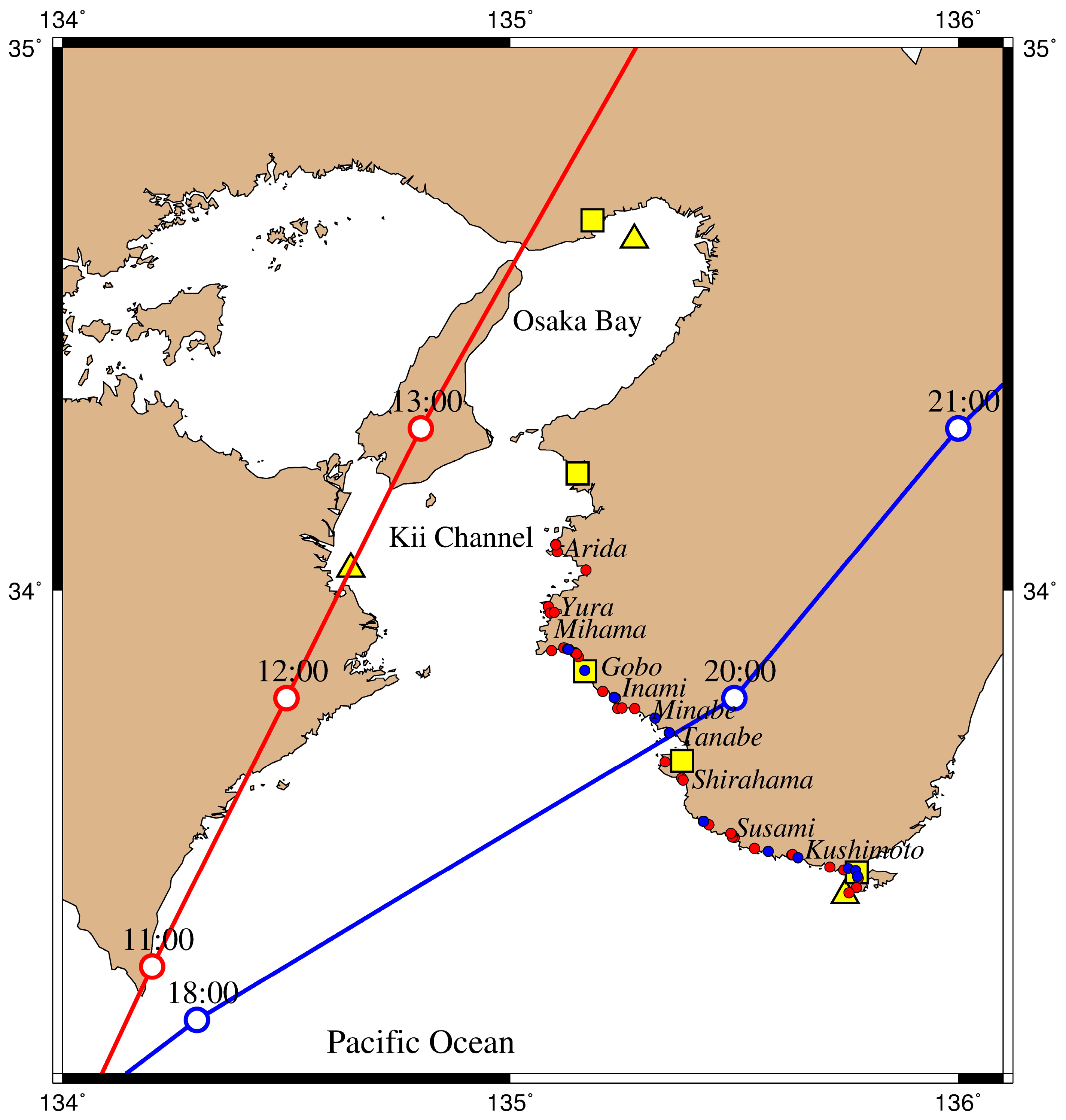
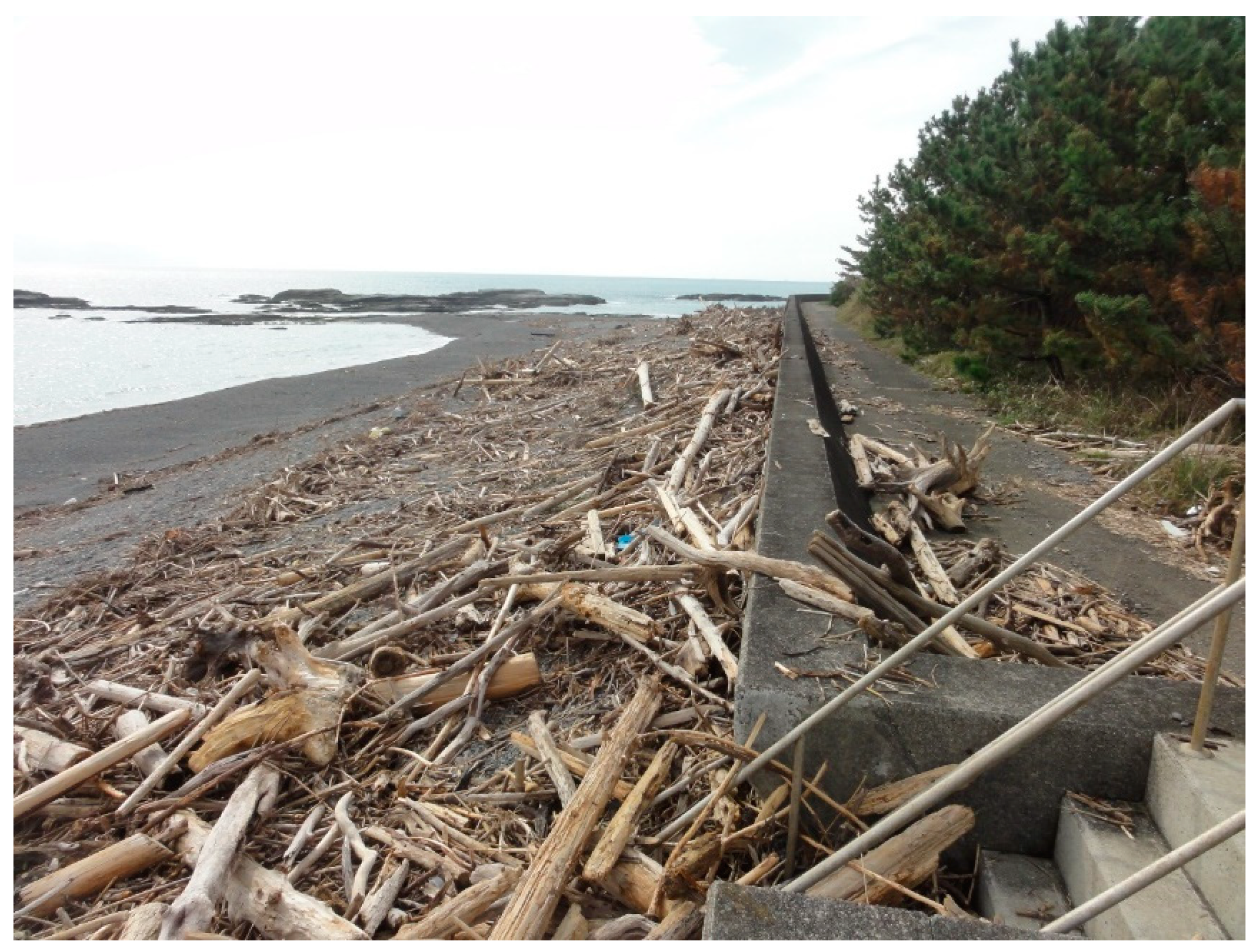
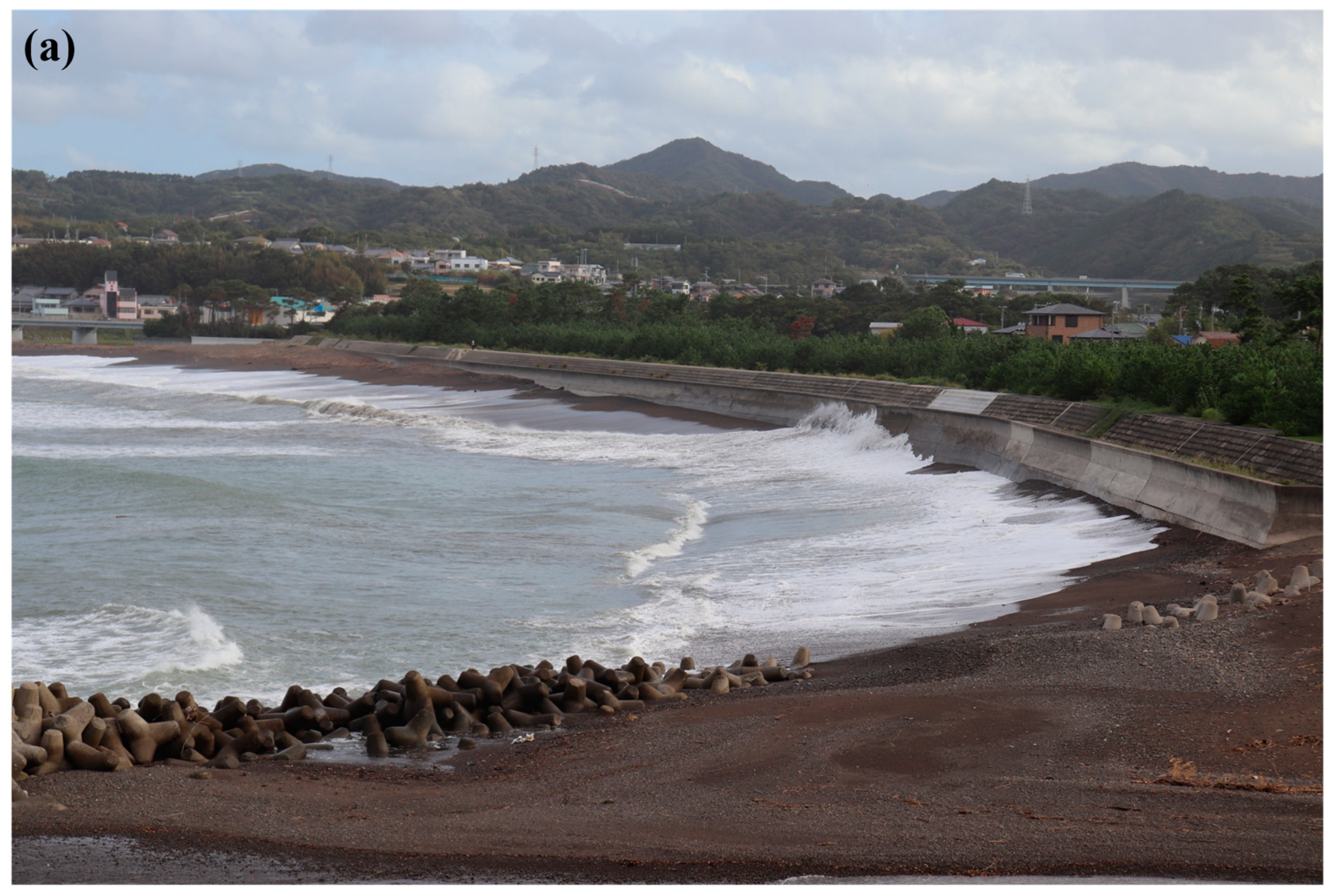
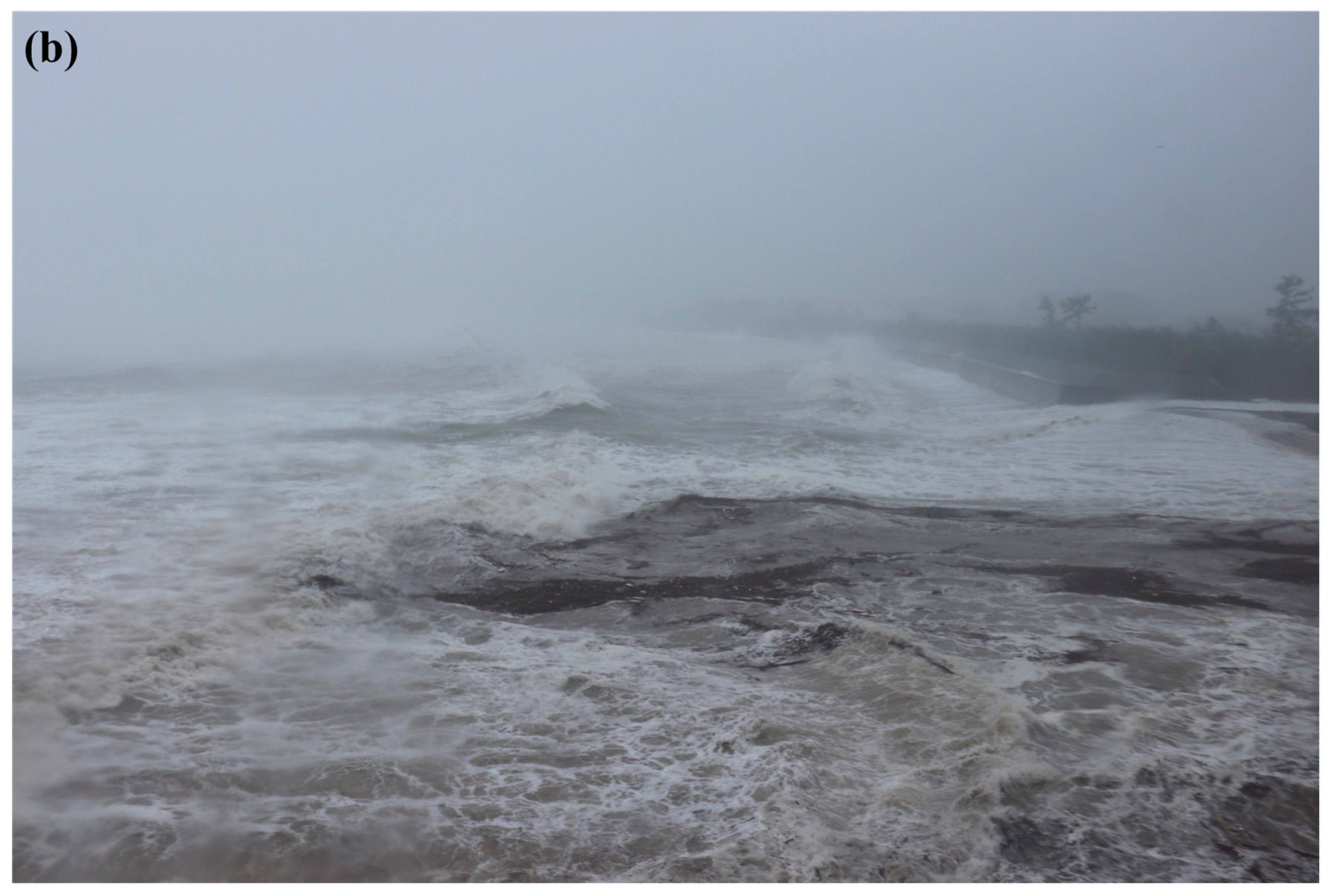
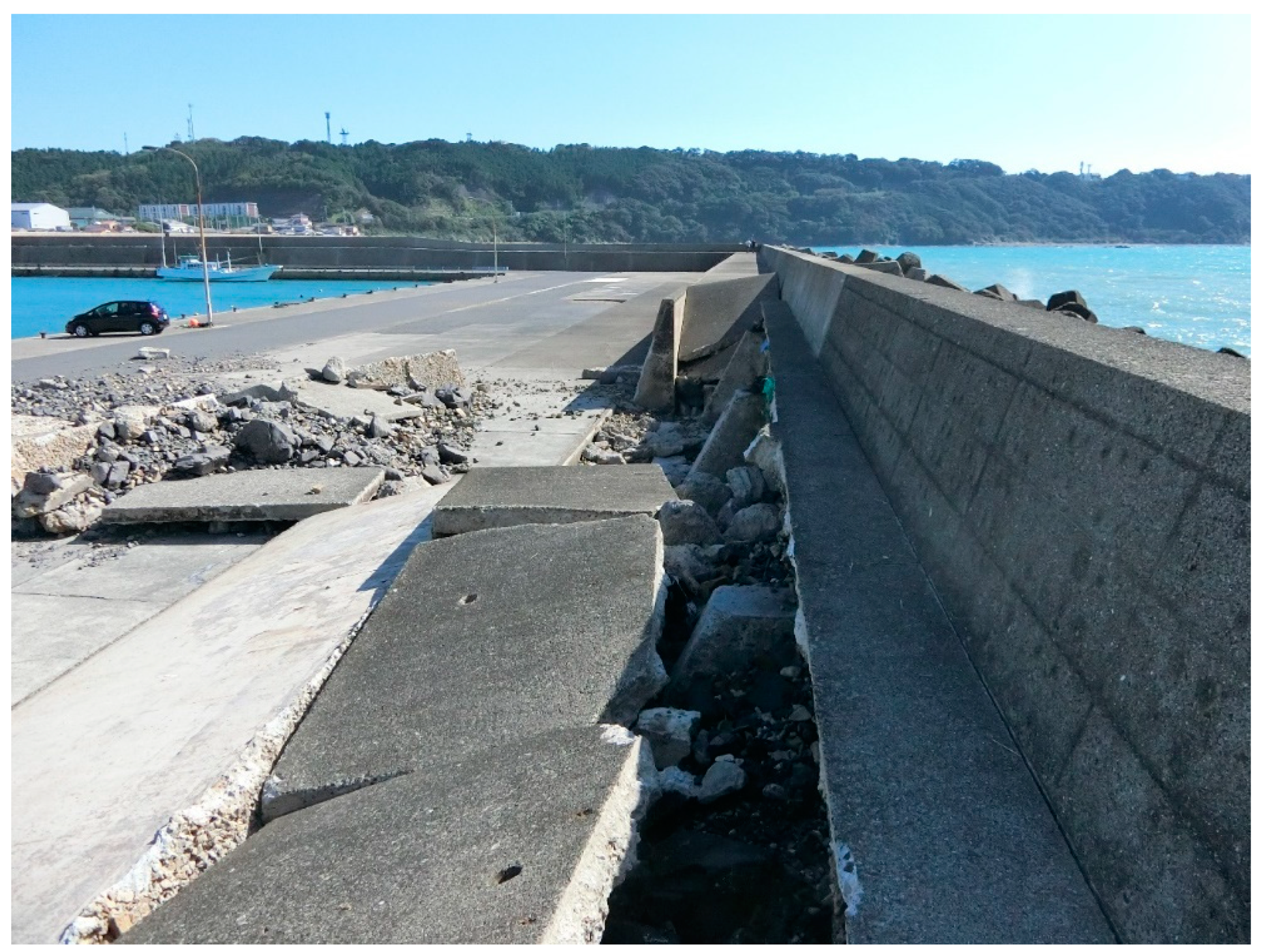
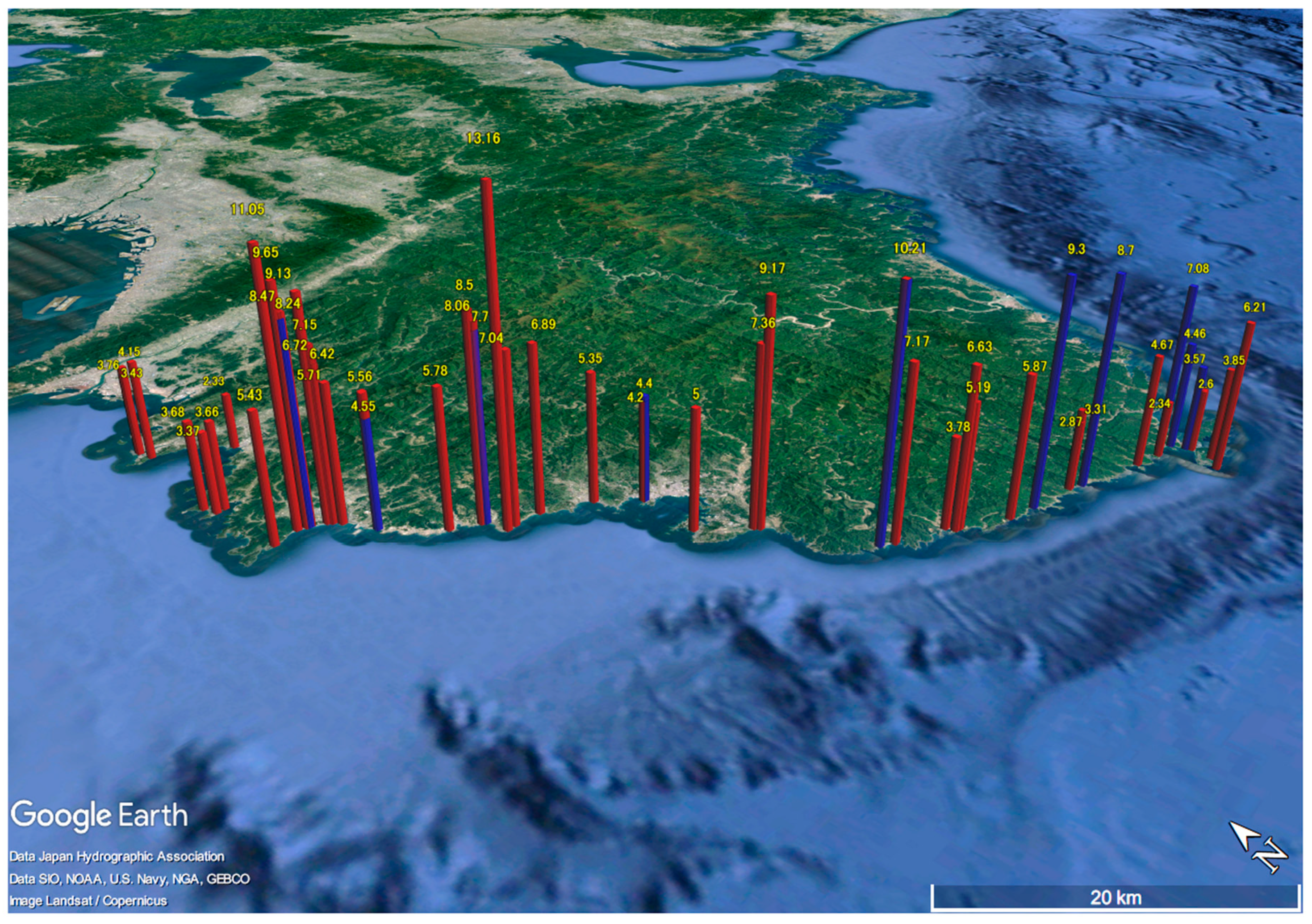
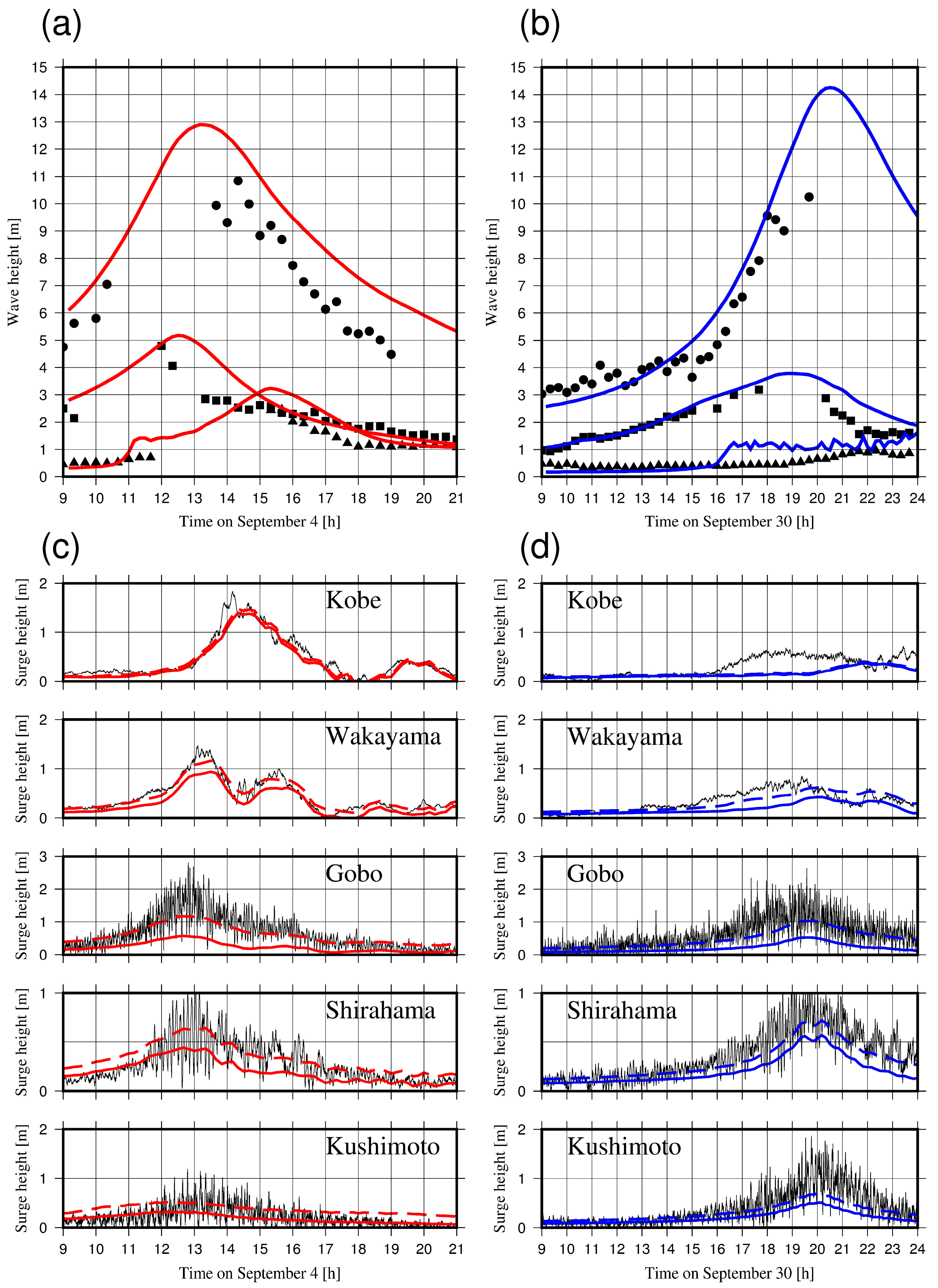
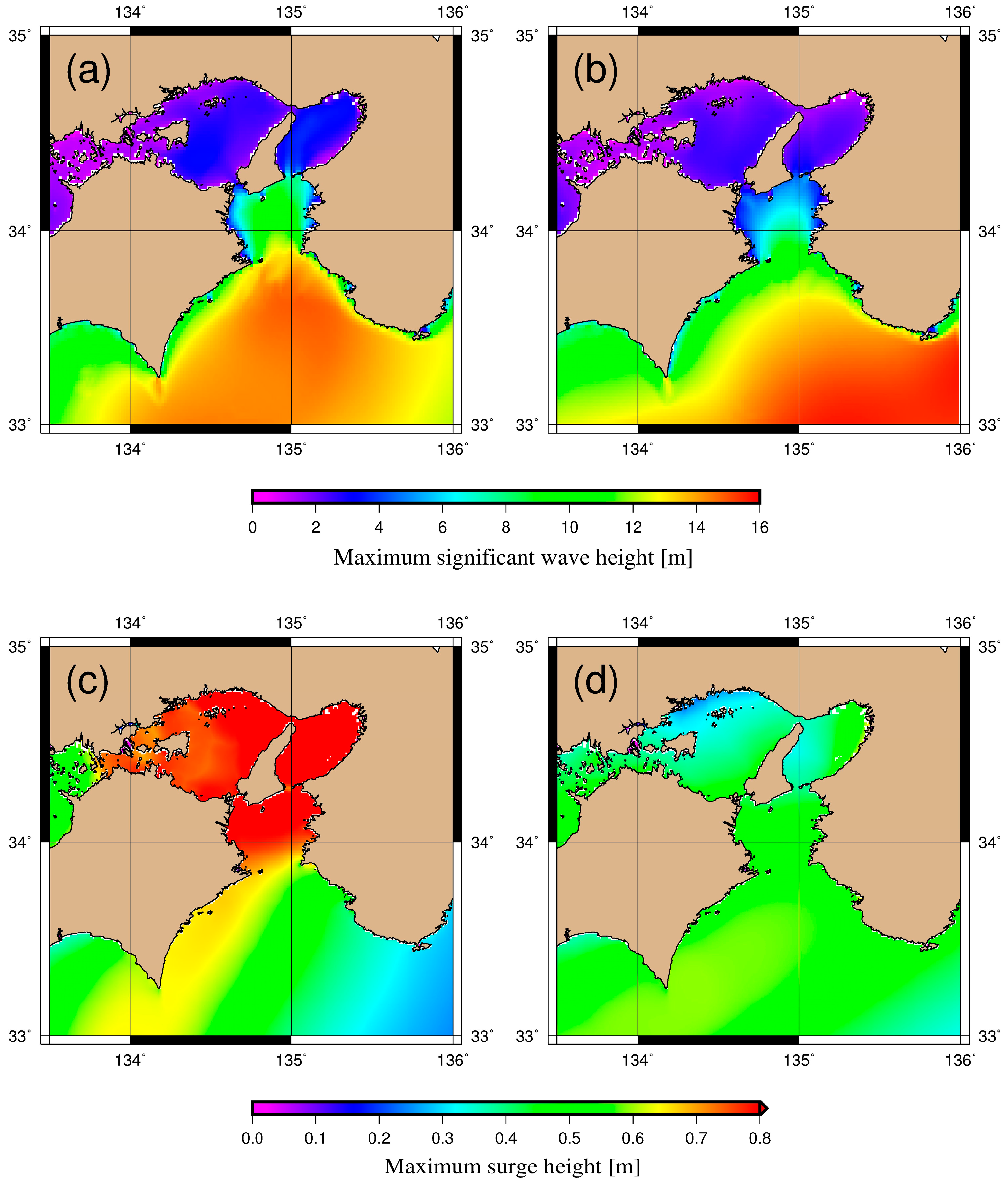
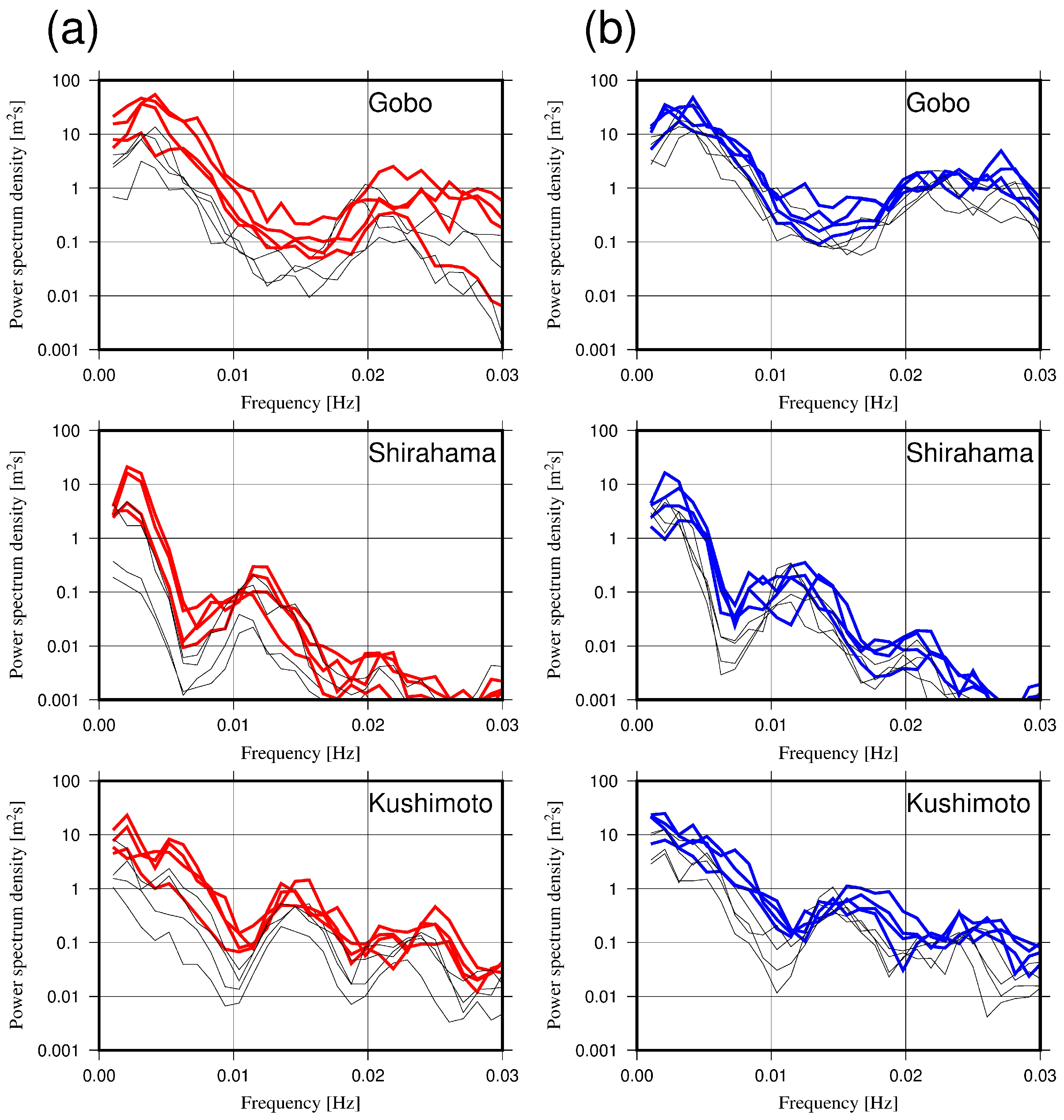
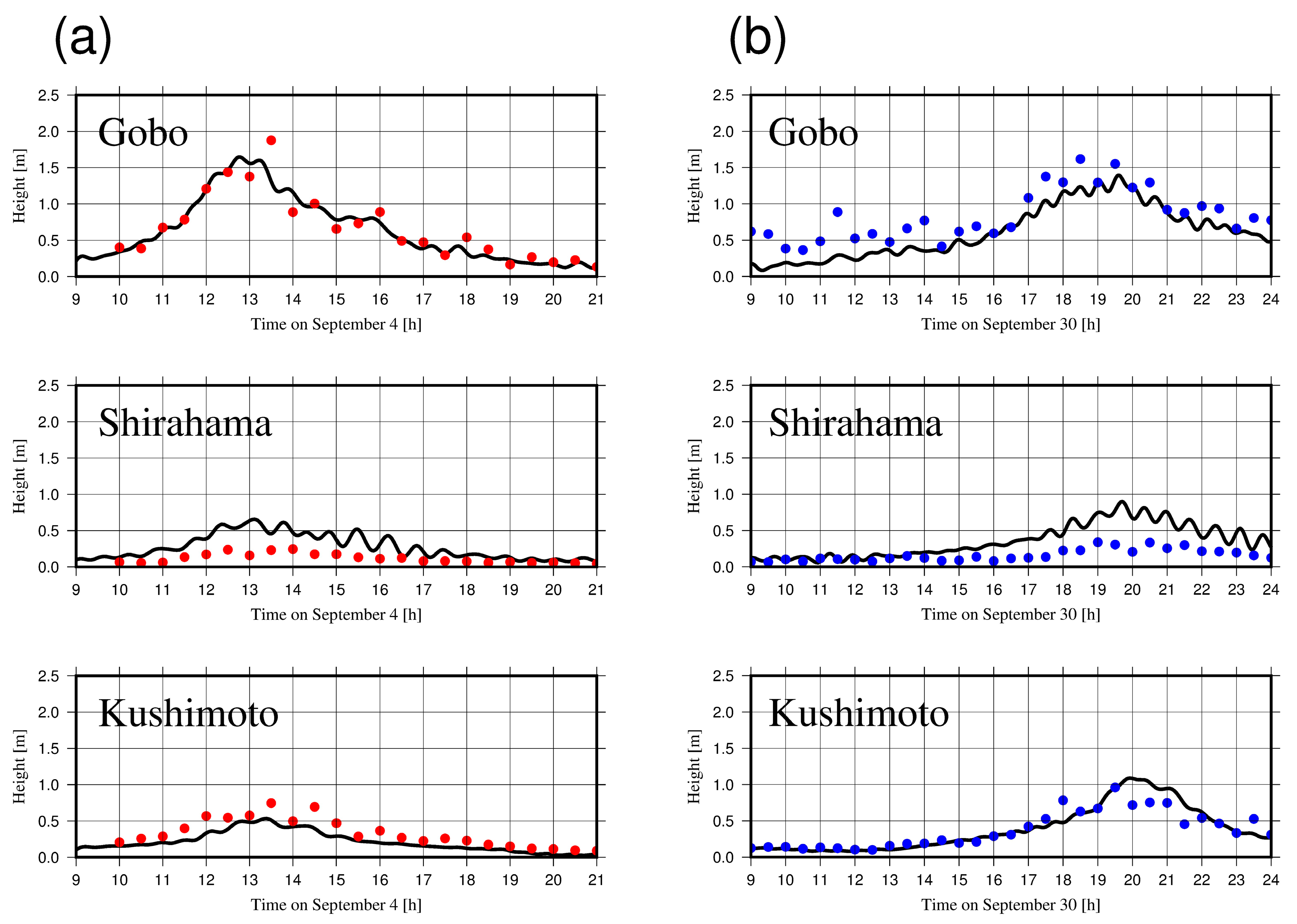

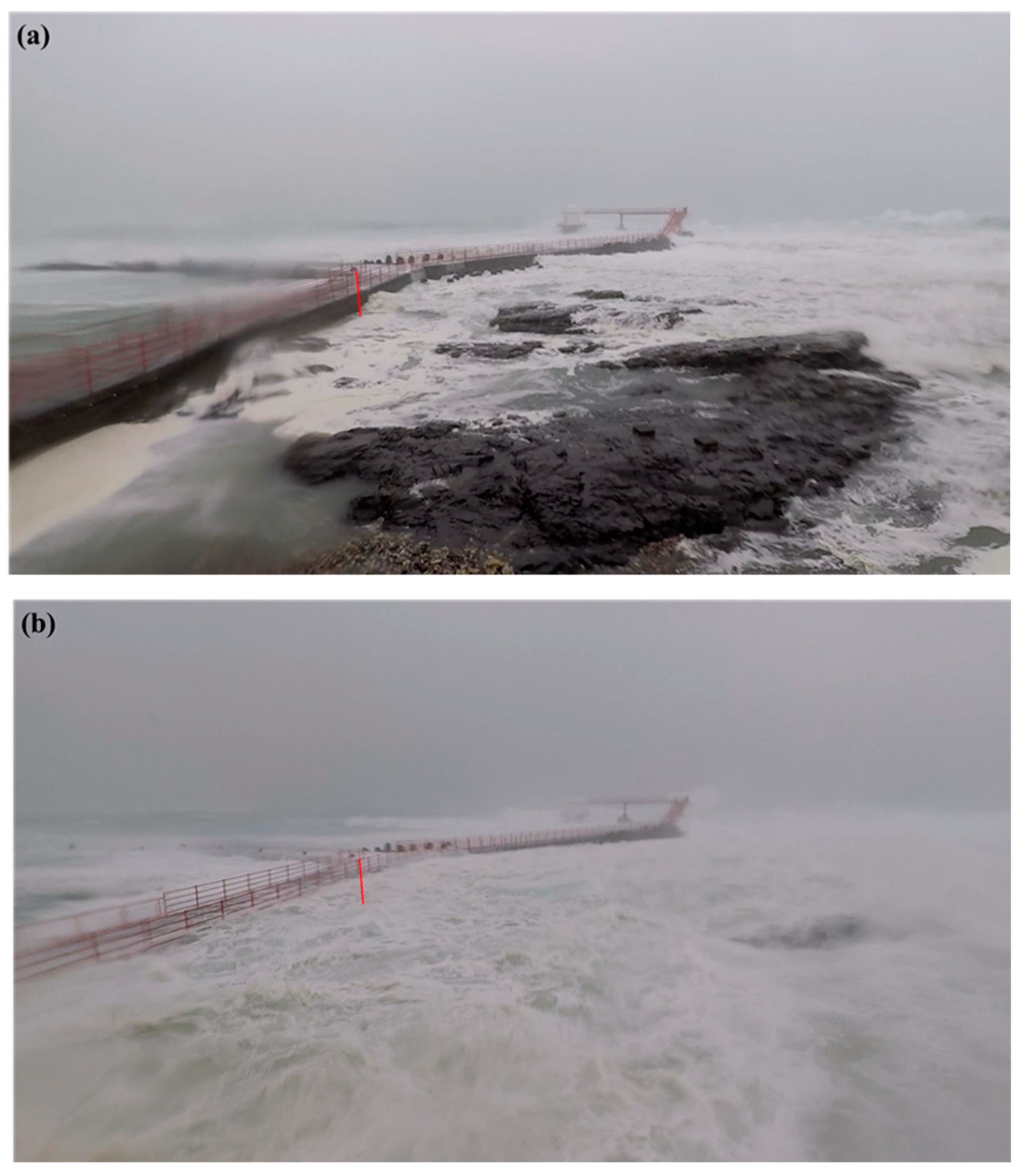

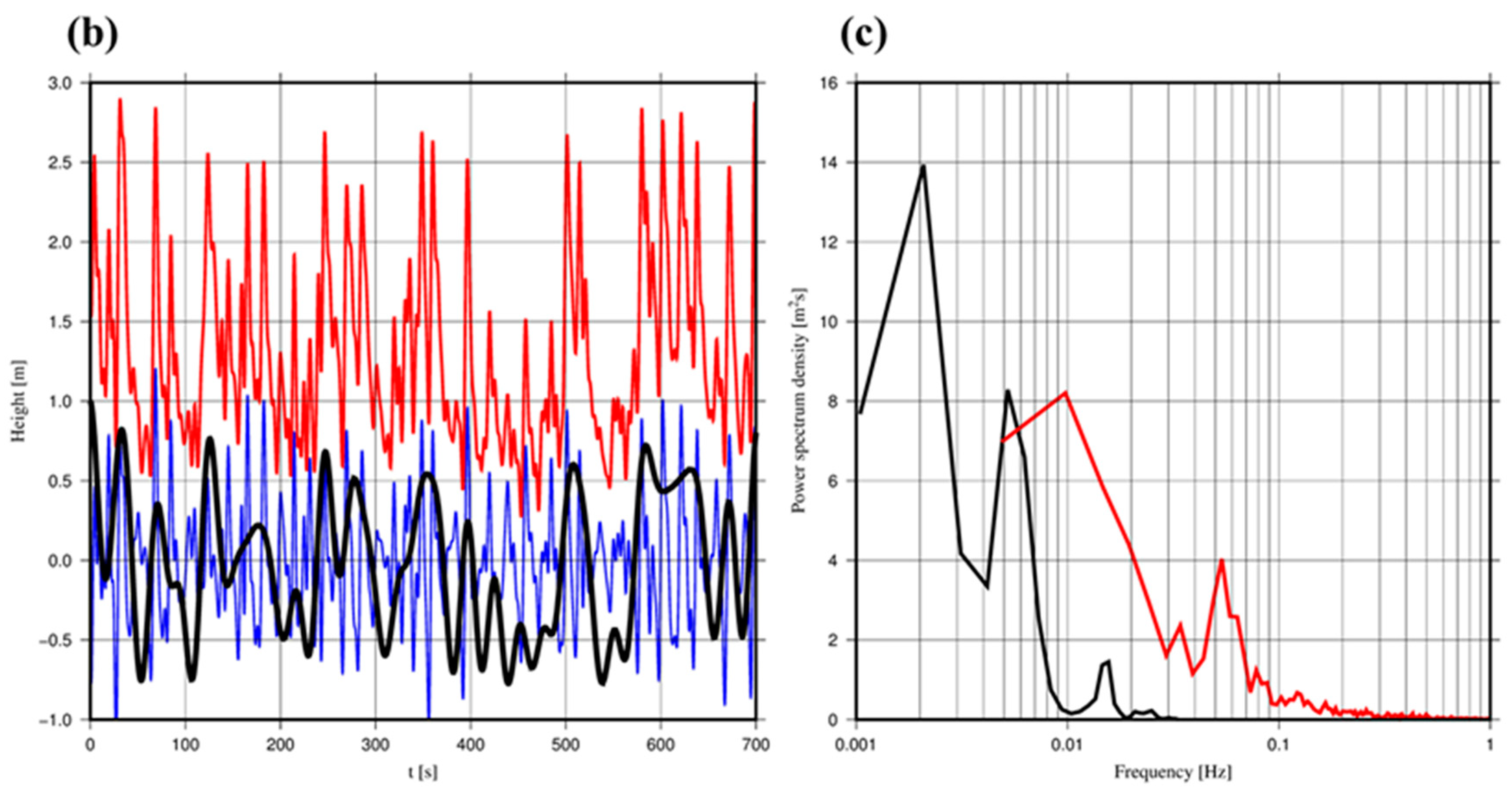
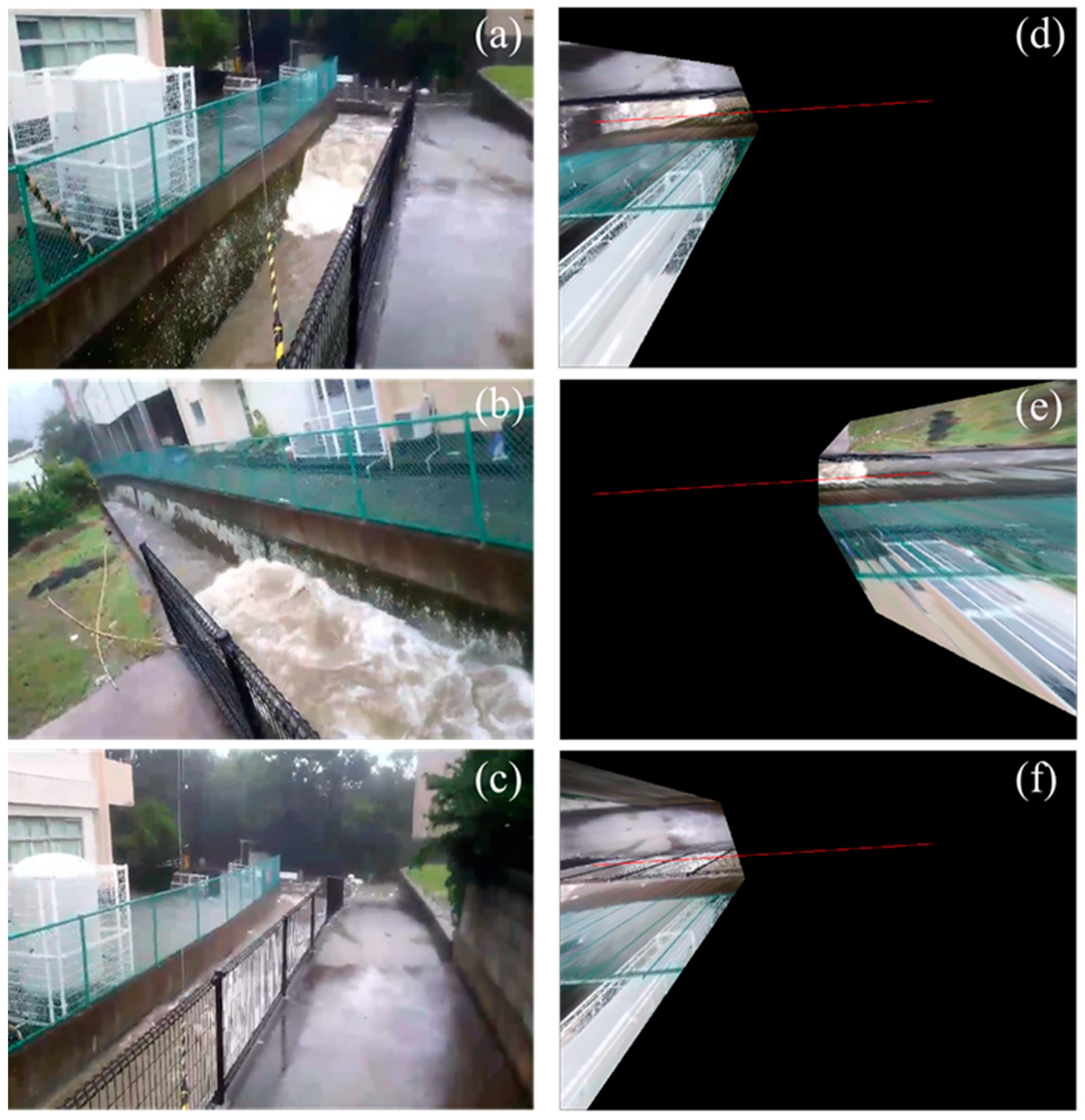
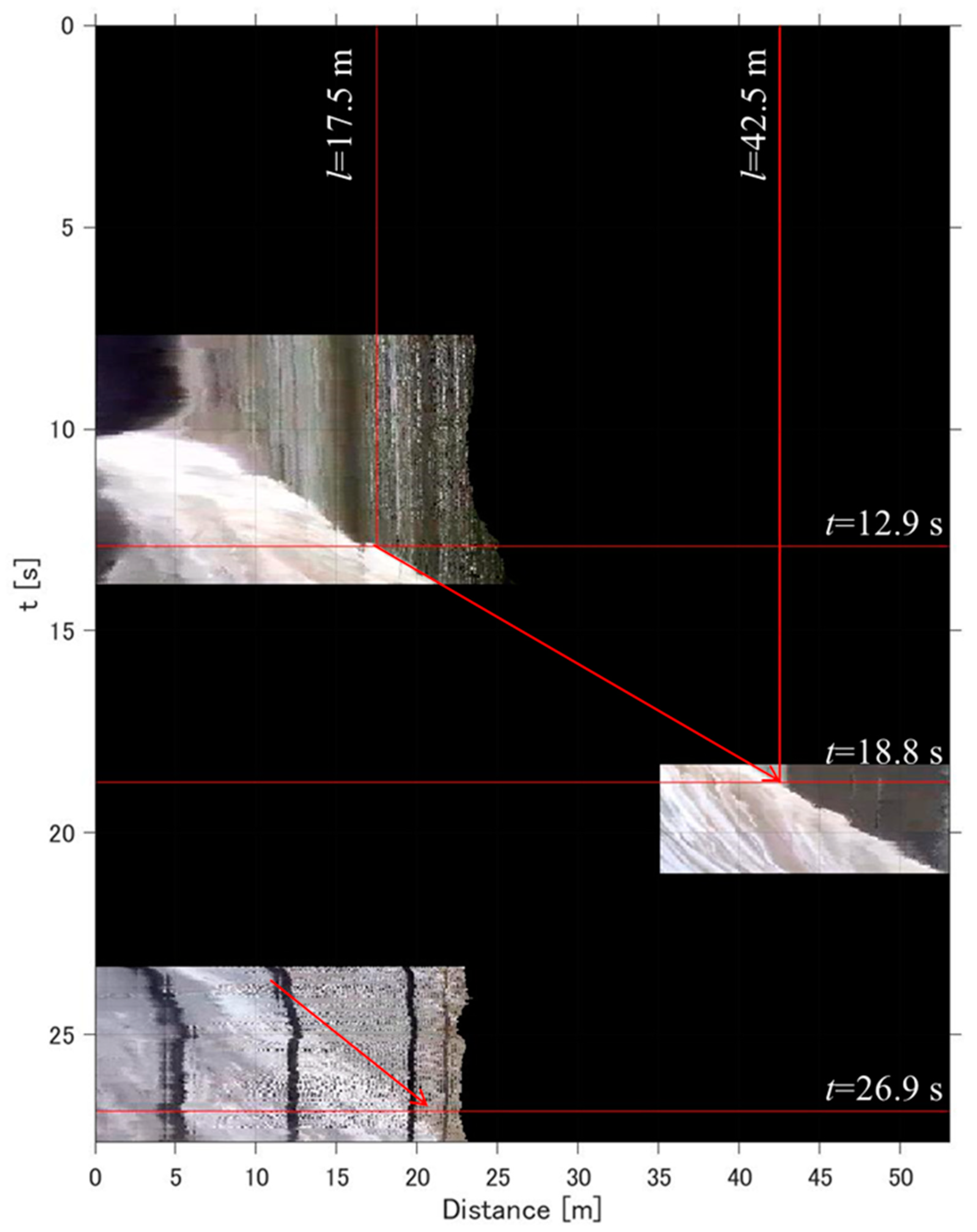
© 2019 by the authors. Licensee MDPI, Basel, Switzerland. This article is an open access article distributed under the terms and conditions of the Creative Commons Attribution (CC BY) license (http://creativecommons.org/licenses/by/4.0/).
Share and Cite
Yamanaka, Y.; Matsuba, Y.; Tajima, Y.; Shibata, R.; Hattori, N.; Wu, L.; Okami, N. Nearshore Dynamics of Storm Surges and Waves Induced by the 2018 Typhoons Jebi and Trami Based on the Analysis of Video Footage Recorded on the Coasts of Wakayama, Japan. J. Mar. Sci. Eng. 2019, 7, 413. https://doi.org/10.3390/jmse7110413
Yamanaka Y, Matsuba Y, Tajima Y, Shibata R, Hattori N, Wu L, Okami N. Nearshore Dynamics of Storm Surges and Waves Induced by the 2018 Typhoons Jebi and Trami Based on the Analysis of Video Footage Recorded on the Coasts of Wakayama, Japan. Journal of Marine Science and Engineering. 2019; 7(11):413. https://doi.org/10.3390/jmse7110413
Chicago/Turabian StyleYamanaka, Yusuke, Yoshinao Matsuba, Yoshimitsu Tajima, Ryotaro Shibata, Naohiro Hattori, Lianhui Wu, and Naoko Okami. 2019. "Nearshore Dynamics of Storm Surges and Waves Induced by the 2018 Typhoons Jebi and Trami Based on the Analysis of Video Footage Recorded on the Coasts of Wakayama, Japan" Journal of Marine Science and Engineering 7, no. 11: 413. https://doi.org/10.3390/jmse7110413
APA StyleYamanaka, Y., Matsuba, Y., Tajima, Y., Shibata, R., Hattori, N., Wu, L., & Okami, N. (2019). Nearshore Dynamics of Storm Surges and Waves Induced by the 2018 Typhoons Jebi and Trami Based on the Analysis of Video Footage Recorded on the Coasts of Wakayama, Japan. Journal of Marine Science and Engineering, 7(11), 413. https://doi.org/10.3390/jmse7110413





